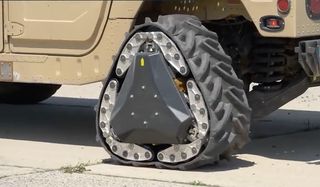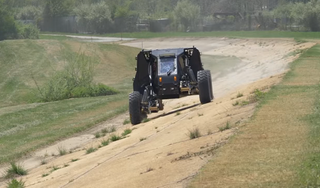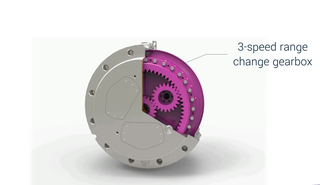DARPA Invents Wheels That Instantly Morph Into Triangular Tank Tracks
The tires transform is just two seconds and the vehicles doesn't have to stop.
By Kyle Mizokami
YOUTUBE/CARNEGIE MELLON
DARPA, the Pentagon's mad science wing, is revolutionizing how ground vehicles move across rough terrain. Its latest breakthrough: round tires that transform into triangular tank tracks in two seconds, without the vehicle needing to come to a stop.
The three things that matter most for tanks are firepower, protection, and mobility. A combat vehicle must pack enough firepower to destroy enemies. It must have the armor to take hits and keep chugging along. And it must have the mobility to maneuver against (and often around) adversaries.
Tank weapons and armor have made major gains in the last 30 years. Mobility, not so much. Ground combat vehicles still use the same track- or wheel-based configuration, with the same pros and cons for each approach. Tracks are more useful for sand and rough terrain, while wheels allow speedy movement over road networks.
But what if you could have both?

The Reconfigurable Wheel Track in Track mode.
DARPA
DARPA’s new Reconfigurable Wheel Track (RWT) program is a set of wheels that can turn into tracks on the fly. In the video above, a Humvee equipped with RWT changes from wheels to tracks while in motion, allowing the vehicle to quickly self-optimize as the terrain changes. The round road wheel transforms into a pyramid-shaped track that increases surface contact with the terrain, lowering the vehicle’s ground pressure and giving it greater traction.
The morphing wheel system was developed by Carnegie Mellon University National Robotics Engineering Center (CMU NREC). RWT can transform from tracks to wheels and back again in two seconds. The Humvee demonstration took place at Aberdeen Test Center, Maryland in May 2018.
Vehicles equipped with RWT will be less constrained by terrain and better at maneuvering against opponents. Consider the following scenario: A U.S. armored column is flying down a highway in the desert, a narrow strip of asphalt among thousands of square miles of sand dunes. The column suddenly encounters an enemy force, straight ahead, defending the road. Rather than sticking on the road and driving right into the enemy’s defenses, the column reconfigures to tracks without stopping, peels off the road, and veers off into the desert. The next thing the enemy knows, he’s being hit with a surprise attack to his flank.

The Multi-mode Extreme Travel Suspension (METS) system showing off vertical travel mode.
DARPA
That’s not the only impressive tech DARPA showed off at the event. The Multi-mode Extreme Travel Suspension (METS) system protects troops from a rough ride, smoothing it out so that soldiers aren’t fatigued by a difficult cross-country trip. METS can adjust the vehicle’s suspension to account for uneven terrain, bumpy terrain.
Another technology that has major implications is the Electric In-hub Motor. The system places an entire 100-kilowatt motor within a standard military 20-inch rim, including three gears, a liquid-cooled internal brake, and a central tire inflation system. A vehicle with this system wouldn’t need a large central motor inside the armored hull, freeing up that space for something else or allowing designers to shrink the hull size altogether. The loss of a single motor doesn’t render the vehicle immobile, as the remaining motors can still move the vehicle and provide electrical power. This system would undoubtedly be very complicated and expensive, but the benefits to armored vehicles are so obvious it’s inevitable many armies will adopt it.

Electric in-Hub Motor.
DARPA
DARPA's quest to change how vehicles get around is called the Ground X-Vehicle Technologies (GXV-T) program, which is meant to reduce vehicle size and weight by 50 percent, crew size by 50 percent, double vehicle speed, allow access to 95 percent of all terrain types, and reduce the enemy’s ability to detect the vehicle at distance. None of the tech involved will make it into current generation military vehicles, and much of it probably needs work before it is tough enough to go to war. But DARPA’s pioneering work shows the direction ground combat is headed and what our military vehicles might be equipped with 15 or 20 years from now.
No comments:
Post a Comment